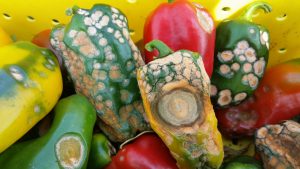Cucurbit powdery mildew (CPM), caused by Podosphaera xanthii, is one the most important diseases of cucurbit crops throughout the world. The pathogen is an obligate parasite, just like cucurbit downy mildew, meaning it needs a living host in order to survive. In northern regions that have a killing frost in the fall the pathogen will die out when the crop freezes. Not being able to overwinter, the pathogen must be re-introduced each spring or summer in the mid-Atlantic region. The pathogen accomplishes this by re-infecting cucurbit crops in the spring as they are planted up the east coast starting in Florida, then the Carolina’s, Virginia, and so forth. By late May, as soon as cucurbit crops begin to germinate in the mid-Atlantic region, the potential threat for potential powdery mildew infections begin. [Read more…]
Quick reviews of fungicide chemistries, FRAC groups, and fungicide resistance management
Did you know that first EBDC fungicide was registered for use in vegetable crops in 1964 followed by chlorothalonil in 1966. Historically speaking, the first New Jersey Vegetable Production Recommendations Guide was produced in 1969 and was only 33 pages long (it’s 450 pages now). Things have changed significantly over the past 54 years when it comes to pest management! For a quick review on fungicides, FRAC groups, and managing fungicide resistance development please click on the links below.
Using tank mixes and fungicide rotations and information on FRAC group 4, FRAC group 7, and FRAC group 3 and FRAC group 11 fungicides.
Diagnosing Verticillium Wilt in Eggplant
Verticillium wilt has been reported in eggplant this summer. It is a common soil-borne fungal pathogen that once it has infested soil can remain for a very long time. Verticillium wilt is caused by either Verticillium albo-atrium or Verticillium dahlia and has a wide host range (over 200 plant species). Both pathogens can survive (overwinter) as microsclerotia in the soil. Verticillium wilt prefers cooler weather and drier soils and can be more severe in neutral to alkaline soils. Solanaceous weeds such as Nightshade may harbor the pathogen. [Read more…]
Cucurbit Downy Mildew Alert – Cucumber – 7/2/23
Cucurbit downy mildew has been confirmed on cucumber in Gloucester County (7/1) and in Atlantic County (6/13) in southern New Jersey. This is the second report of CDM in the state and region this growing season. All cucumber and cantaloupe growers should scout on a daily basis and initiate a preventative fungicide program immediately. All other cucurbit plantings need to be scouted on a regular basis. CDM was last confirmed on cucumber and butternut squash in coastal South Carolina. Remember, some CDM isolates fall into Clade I which predominately infect watermelon, pumpkin, and squash, where CDM isolates in Clade II predominately infect cucumber and cantaloupe.
For more information on CDM, the clades, and CDM control please click here.

Cucurbit downy mildew sporulating on the underside of an infected cucumber leaf.
Preparing for Pepper Anthracnose in 2023

Pepper Anthracnose
Pepper anthracnose caused by Colletotrichum spp. has become a significant problem on some farms in southern New Jersey.
Unlike in tomato, where symptoms are only present in mature (red) fruit, pepper anthracnose can infect pepper fruit at any growth stage. Currently, there are no commercially-available bell or non-bell peppers with known resistance to anthracnose. [Read more…]
Vegetable Disease Update: 06-30-23
- Cucurbit downy mildew has been reported on cucumber in New Jersey. For more information on CDM control please click here.
- There have been no reports of Late blight in potato or tomato in the region to date. To follow the progress of Late blight in the US please click here.
- Bacterial leaf spot has been reported in pepper. More more information on BLS control please click here. Rutgers is surveying tomato and pepper fields throughout the state this summer to help determine the makeup of the bacterial population and for copper resistance development.
- Powdery mildew has been reported in cucurbit crops. For more information on the control of CPM please click here.
- Southern blight has been reported on pepper.
- Bacterial canker has been reported in tomato. For more information on diagnosing important tomato diseases please click here.
- Phytophthora blight has been reported on pepper. For more information on controlling Phytophthora blight please click here.
- For information on diagnosing important pepper diseases please click here.
- The 2022/2023 Commercial Vegetable Production Recommendations Guide is available for free online or for sale in hardcopy form at many County offices.
- For a quick review on managing fungicide resistance development using tank mixes and fungicide rotations, and information on FRAC group 4, FRAC group 7, and FRAC group 3 and FRAC group 11 fungicides please click on hyperlinks.
